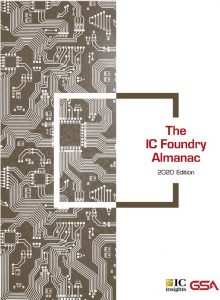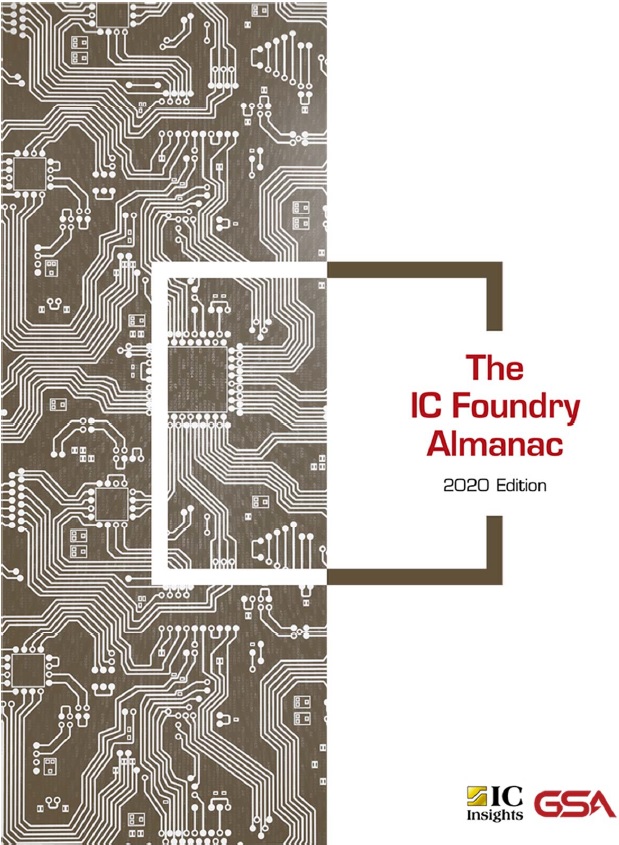 When I first started working with the foundries 25 years ago I would have never imagined that I would make a career out of it, which I most certainly have. Fortunately, I recognized early on that not only are the foundries the cornerstone of the semiconductor ecosystem, they are also a very important economic bellwether, absolutely.
When I first started working with the foundries 25 years ago I would have never imagined that I would make a career out of it, which I most certainly have. Fortunately, I recognized early on that not only are the foundries the cornerstone of the semiconductor ecosystem, they are also a very important economic bellwether, absolutely.
When I first started, a fabless company could use four different foundries (TSMC, UMC, SMIC, and Chartered) in a reasonably compatible manner. Generally, TSMC would be first to a process node so everyone started there and moved chips to the cheaper foundries for 2nd, 3rd, and even 4th source manufacturing. This was not really ideal for TSMC as they did all of the heavy process ramp work only to share the more profitable high volume manufacturing with competitors.
This all changed in 2011 at 28nm when TSMC followed Intel using High-k Metal (HKMG) gate-last technology. The other foundries followed Samsung in using a gate-first HKMG 28nm technology which did not yield as expected. TSMC then went on to dominate the 28nm node and has been dominant ever since.
The days of TSMC compatible processes are now long gone with the FinFET era and TSMC continues to lead the semiconductor industry with the first high volume manufacturing EUV FinFET implementation at 7nm, 6nm, and 5nm. TSMC will continue to use FinFET EUV technology at 3nm then move to GAA at 2nm. Samsung is still working on perfecting EUV at 7nm and 5nm before moving to GAA at 3nm. Intel 7nm will be EUV FinFETs but Intel 5nm will be horizontal nanosheets and CFETs for Intel 3nm . It is hard to bet against TSMC but I would not bet against Intel or Samsung either.
Bottom line: The foundry business is thriving as systems companies do even more of their own chips and continue to push innovation to the limits of the fabless semiconductor ecosystem.
One of the reports I rely on for my foundry expertise is the IC Foundry Almanac published by the GSA in cooperation with IC Insights. The 2020 (12th) Edition is out now and it continues to reinforce my 20+ year belief that the foundries are in fact the cornerstone of the semiconductor industry.
The report itself can be purchased from the GSA Store. I have a copy so if you have questions I may be able to help in the comments section or contact GSA directly. It is definitely worth the price of admission if you really want to know what is happening inside the fabless semiconductor ecosystem. Here is the executive summary:

The importance of wafer foundries continues to grow in the integrated circuit industry. About 43% of worldwide IC sales to systems makers in 2019 were coming from products fabricated by third-party silicon foundry providers compared to 36% in 2014 and 24% in 2009. Foundry-made ICs are expected to account for more than 40% of total integrated circuit sales to systems makers through 2023, according to the 2020 edition of The Foundry Almanac, which is jointly produced by the Global Semiconductor Alliance (GSA) and IC Insights Inc. The 12th annual edition of The Foundry Almanac shows worldwide IC foundry sales increasing by a compound annual growth rate (CAGR) of 6.4% between 2018 and 2023. This foundry growth rate is
higher than the expected 4.8% CAGR for total IC sales in the same forecast period. Currently, pureplay foundry suppliers generate about 81% of total IC foundry sales with the remaining 19% coming from integrated device manufacturers (IDMs) that process wafers for other companies in addition to making their own products in internal fabs.
The first part of this report contains an overview of the semiconductor foundry segment, forecasts, and analysis of trends by IC Insights. Following the market forecast section, the GSA presents a summary of foundry wafer pricing trends and photomask costs based on industry survey results. This report also contains a listing of foundry-supplier information compiled by the GSA.
Among the key conclusions and highlights in The 2020 IC Foundry Almanac are:
- Total IC foundry sales (by both pure-play foundries and IDMs) are estimated to declined 2% in 2019 to $69.6 billion after increasing 5% to reach a record-high $72.6 billion in 2018. The last time IC foundry sales dropped was in 2009, when the semiconductor industry was hit by a downturn year after the financial crisis in 2008 triggered a deep global recession. In 2019, foundry sales slid lower because of growing concerns about an economic slump, which cause system makers to reduce IC purchases, and by slower growth in China that was partly a result of its trade war with the U.S.
- Foundry growth is expected to return in 2020 with total sales rising 6% and setting a new alltime high of $73.6 billion. Total foundry sales (by both pure-play and IDM suppliers) are forecast to grow 8% in 2021 and strengthen in the next two years to reach $96.6 billion in 2023.
- Pure-play foundry sales in 2020 are projected to grow 8% to a record-high $60.8 billion after falling 2% in 2019 and rising 5% in 2018. Pure-play foundry sales are expected to grow by a CAGR of 7.0% between 2018 and 2023 to reach $81.2 billion, driven by strong demand from fabless IC companies, increased outsourcing by IDMs, and shipments of custom-designed integrated circuits to systems houses, such as Apple in the U.S. and Huawei in China.
- Foundry revenues generated by IDMs making ICs for other companies are forecast to drop 2% in 2020 to $12.8 billion after declining about 2% in 2019 and growing 3% in 2018. IDM foundry sales are projected to rise by a CAGR of 3.1% in the 2018-2023 period to reach $15.4 billion in the final year of the forecast.
- Wafer-fab process technology with minimum feature sizes below 40nm generated about 47% of pure-play foundry sales in 2019 (estimated at $26.8 billion). Process technology with minimum feature sizes of 40nm or greater accounted for 53% of total pure-play foundry revenue in 2019 (estimated at $29.7 billion). Pure-play foundry sales for ICs made with <40nm technology increased 5% in 2019, while revenue for devices made with ≥40nm processes declined by 8% in the year.
- Capital expenditures by IC foundries (both pure-play and IDM suppliers) grew 7% in 2019 to an estimated $23.9 billion after falling 15% in 2018 from a record-high $26.4 billion in 2017. Foundry capex in 2019 is estimated to be the second highest level of spending in a year. In 2020, foundry capital spending is expected to show a modest 4-5% increase with some major pure-play foundry suppliers remaining cautious and keeping their capex flat in the year.
- Foundry wafer-fab utilization rates slid lower in 2019 because of a slowdown in IC purchases due to increasing uncertainty about global economic growth in the year ahead. Fab-capacity utilization at the four largest pure-play IC foundries (TSMC, GlobalFoundries, UMC, and SMIC) collectively stood at an average of 82% in 2019, down from 89% in 2018 and 90% between 2015 and 2017. In 2019, the “Big 4” pure-play foundries increased their combined installed fab capacity by 4% to nearly 49.3 million 200mm equivalent wafers compared to about 47.6 million wafers in 2018.
- Fabless customers are estimated to account for 66% of pure-play foundry revenue in 2019 with IDMs representing 15% and systems makers being 19% of total sales. In 2010, the sales split was 76% to fabless customers, 23% to IDMs, and just 1% to systems manufacturers. The share of systems makers directly buying foundry-made ICs has climbed with Apple using Samsung and TSMC to fabrication of its custom-designed processors in iPhones, iPads, and other products as well as some Chinese smartphone and end-equipment makers—like telecom giant Huawei—developing integrated circuits that are made by foundries.
- Communications ICs represented an estimated 57% of total pure-play foundry sales in 2019, followed by 17% for “other” ICs (for such applications as automotive, industrial, and medical systems), 14% for computer ICs, and 12% for consumer-product ICs.
- Customers based in the Americas accounted for 56% of estimated pure-play foundry sales in 2019, followed by those headquartered in the Asia-Pacific region at 32%, Europe at 6%, and Japan at 5% of the total. China’s share of the pure-play foundry market in 2019 is estimated at about 18%, which is four percentage points greater than the marketshare of customers in the rest of the Asia-Pacific region in the year.
- Two Chinese chipmakers (SMIC and Huahong Group) are ranked among the top 10 IC foundries in 2019, based on dollar-sales estimates. In total, Chinese manufacturers accounted for an estimated 9.4% of worldwide pure-play foundry sales in 2019, down slightly from 9.6% in 2018. The marketshare of China’s pure-play foundries remains below the peak of 13.3% recorded in 2006 and 2007. Mainland Chinese companies in the pure-play foundry business are expected to have a marketshare of 10.3% in 2023.
- Two IDMs (Samsung and Fujitsu) are among the top 13 IC foundry suppliers in 2019. The rest are pure-play foundries. Fujitsu is expected to fall out of the top ranking of foundries in 2020 after it sold the remaining majority interest in its 300mm fab in Japan to Taiwan-based UMC in the summer of 2019.
- Worldwide IC foundry production capacity (at both pure-play and IDM foundries) grew by about 5% in 2019 to an estimated 80.4 million wafers (measured in 200mm equivalents). Pure-play foundry annual capacity grew by an estimated 5% to about 63.8 million wafers in 2019, while IDM foundry capacity increased 4% to an estimated 16.6 million 200mm-equivalent wafers in the year. The “Big 4” pure-play foundries (TSMC, GlobalFoundries, UMC, and SMIC) accounted for an estimated 61% of total IC foundry capacity in 2019. Total foundry capacity (at both pureplay suppliers and IDMs) is forecast to rise 4% in 2020 to about 84.0 million 200mm-equivalent wafers, followed by another 4% increase in 2021 to 87.7 million in that year.
- Overall, 200mm wafer fabrication pricing gradually increased from the second quarter of 2018 continuing through the second quarter of 2019 resulting in a 10% increase YoY. Furthermore, 300mm wafer fabrication pricing was relatively stable during the same period with a 2% decrease YoY. This reflects the stable demand for devices at older technology nodes using 200mm size wafers compared to newer technology nodes using 300mm wafers affected by the global slowdown.
- GSA’s Wafer Fabrication Pricing Survey results show that participants still rely on older process nodes to maintain market share, as 49% of the capacity needs are at or above the 130nm node. Participants are also reporting an increase in demand for capacity at nodes below 50nm with 33% of participants needing capacity at these nodes compared to 24% last year.
- 200mm mask costs per layer remained flat throughout 2018. 300mm mask costs per layer, driven by the 28nm node, increased throughout 2018, continuing through the second quarter of 2019. This could be driven by the increase in complexity of the designs run on 300mm wafers.
- With the downturn in 2019, wafer fabrication capacity became more available, which was reflected by the outlook of GSA survey participants. 82% of GSA’s 200mm wafer fabrication survey participants and 70% of 300mm wafer fabrication survey participants are forecasting that wafer fabrication pricing will be trending lower in the next 6 months.








Flynn Was Right: How a 2003 Warning Foretold Today’s Architectural Pivot